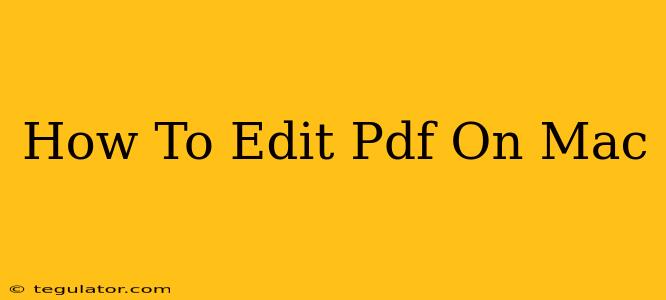Editing PDFs on a Mac is easier than you might think. Whether you need to make quick changes or perform extensive edits, several methods are available, catering to different needs and technical skills. This guide will walk you through the best options, highlighting their strengths and weaknesses.
Choosing the Right PDF Editor for Your Needs
Before diving into the specifics, it's crucial to identify the type of editing you need to perform. Are you simply adding annotations, or do you need to modify the text and images within the document? Different tools excel at different tasks.
1. For Simple Annotations and Markup: Preview
Mac's built-in Preview app is a surprisingly powerful tool for basic PDF editing. It's free, readily accessible, and perfect for quick tasks like:
- Adding Text: Use the annotation tools to add text boxes directly onto the PDF.
- Highlighting and Underlining: Easily highlight important sections or underline key phrases.
- Drawing Shapes and Lines: Add shapes, lines, and arrows for visual emphasis.
- Adding Stamps: Include pre-defined stamps like "Approved" or "Confidential."
- Adding Signatures: You can even add your signature using your trackpad or a connected device.
How to use Preview: Open your PDF in Preview. The annotation tools are located in the toolbar at the top of the screen.
2. For Advanced Editing: Adobe Acrobat Pro DC
For more extensive editing, including changing text, images, and manipulating page layouts, Adobe Acrobat Pro DC is the industry standard. While it's a subscription-based service, the power and precision it offers are unmatched. Features include:
- Text Editing: Directly edit existing text within the PDF, changing fonts, sizes, and styles.
- Image Editing: Replace, resize, and reposition images within the document.
- Page Manipulation: Add, delete, rotate, and rearrange pages with ease.
- Form Filling and Creation: Easily fill out interactive forms or create your own.
- OCR (Optical Character Recognition): Convert scanned documents into editable text.
Considerations: Acrobat Pro DC is a paid application, and its robust feature set might be overkill for simple tasks.
3. Free and Open Source Options: Sejda, PDFescape
For those seeking free alternatives, several excellent options are available online and as desktop applications. Sejda and PDFescape are popular choices, offering a range of editing features without the price tag of Adobe Acrobat. They typically offer both online and desktop versions. Features often include:
- Basic Text Editing: Often limited compared to Acrobat Pro but sufficient for minor corrections.
- Image Editing: Basic image manipulation capabilities.
- Annotation Tools: Similar to Preview, but potentially with more advanced options.
Considerations: Free options often have limitations on file size or the number of edits you can make within a given timeframe.
Tips for Efficient PDF Editing on Mac
Regardless of the tool you choose, consider these tips for a smooth editing experience:
- Backup Your Original: Always create a backup copy of your original PDF before making any edits.
- Organize Your Layers: If using a tool with layers (like Acrobat Pro), keep your edits organized for easy management.
- Save Regularly: Save your work frequently to prevent data loss.
- Choose the Right Tool: Select the editor that best matches your editing needs to avoid wasting time on overly complex software.
Conclusion
Editing PDFs on a Mac is achievable with a variety of tools, from the simple and free Preview app to the powerful (but paid) Adobe Acrobat Pro DC. By understanding your editing requirements and selecting the appropriate software, you can efficiently and effectively manage your PDF documents. Remember to always back up your original files and save your progress regularly!

